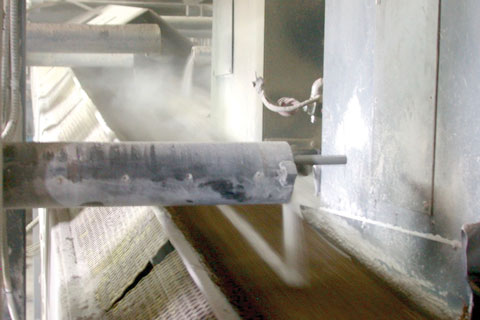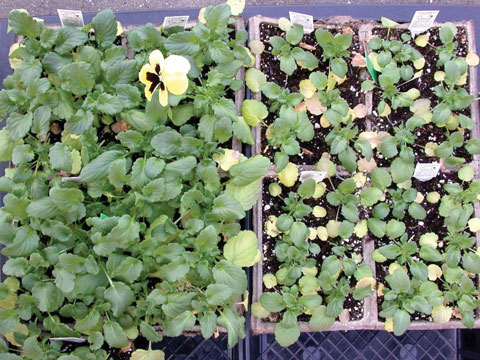5/1/2018
DIY or DIFM Growing Media?
Ed Bloodnick

Most growers have pondered whether to purchase a pre-formulated growing media or if they should mix their own. You could compare growing media to the baking industry: You can buy all the ingredients to get up early each morning to bake your own bread or you can go to the supermarket and choose from a wide assortment of bread that’s readily available, consistent, quality controlled and at an affordable price. Just like many other materials used in the growing industry, how many growers make their own fertilizers, produce their own seed or process plastic for their own pots and trays? So why would a grower want to make their own growing media?
In some cases, a commercially prepared growing medium may not be available for a specific growing need and the grower may need to blend their own special growing medium. Another reason to make your own growing media may be for cost savings. Depending on the size of your operation and your access to raw materials, blending your own growing medium could save money. If you believe you can save money blending your own growing media, you need to include all the costs to determine if it’s economical for you to blend your own and compare the quality of the finished product.
If you’re considering or currently blending your own growing media and you’re looking at pre-formulated growing media, it’s important to make a good comparison of product specification, quality, consistency, cost, product availability, storage and product performance. Many manufacturers of commercially prepared growing media operate high-tech mixing lines and oversee the production of growing media with specially trained personnel and stringent quality-control methods.
Manufacturers offer a wide array of growing media products for various applications, from seeding, general transplant and specialty applications. Some companies also offer custom-blended products for grower-specific needs and some products with unique ingredients. Most growers can relate to crop costs, so let’s look at some of the costs of blending your own growing media.
Raw materials
Most growing media manufacturers are basic in one or more raw materials. If you add up the cost of the components (peat, bark, coir, perlite, vermiculite, wood fiber, etc.) and additives (limestone, wetting agent, starter fertilizer charge, controlled-release fertilizer, biological additives, etc.) that are used to blend your own growing medium, there may be a small savings, depending on the volume purchased. However, there are additional costs, including handling and blending that must be considered.
Equipment
If you already have equipment in place, then there are few upfront costs: You need to consider the cost of the equipment, amortization and maintenance for the life of the equipment; determine how many years you plan to pay off your equipment; and consider that all equipment requires maintenance, occasional repair and parts. In addition, someone must be paid to maintain and repair the equipment, whether it’s the owner, one of the employees or an outside company. These costs must be included in the cost of your final growing medium if you blend your own.
 In some cases, growing medium may be blended with a front-end loader on a cement pad or by feeding ingredients into a large cement mixer. However, research has shown that it’s difficult to uniformly blend additives and small media components into a growing medium with these methods. This can result in inconsistent growing medium with one pot containing too much limestone or fertilizer and another pot not containing any. This method of blending can cause inconsistencies in the physical characteristics of the growing medium due to the grinding action of the equipment.
In some cases, growing medium may be blended with a front-end loader on a cement pad or by feeding ingredients into a large cement mixer. However, research has shown that it’s difficult to uniformly blend additives and small media components into a growing medium with these methods. This can result in inconsistent growing medium with one pot containing too much limestone or fertilizer and another pot not containing any. This method of blending can cause inconsistencies in the physical characteristics of the growing medium due to the grinding action of the equipment.
Pictured: In a typical growing media manufacturing facility, ingredients are dropped onto a conveyer, then blended to produce a uniform product with minimal damage to the components.
Soil mixers or batch mixers are better at uniformly blending components and additives together, but this equipment can be pricey, depending on the options. Price for a small mixer can start at $10,000 and can be well over $300,000 for an integrated mixing line.
The person responsible for blending should take care not to over-process the growing medium. Some media components are fragile and can easily be broken down during blending, such as controlled-release fertilizers. Breaking controlled-release fertilizer prills will release too much fertilizer and can burn plants. Over-processing of growing media creates fine particles that clog air pores, reducing air porosity of growing medium. Roots need oxygen, so lack of air space will reduce plant growth rates and water usage.
Inconsistency of growing media can cause variations in crop performance, particularly if there’s variance in particle size from batch to batch. This can result in uneven watering/drying out and an uneven effect throughout the crop where some plants are taller, and others are short and stunted.
Regardless of the equipment that’s purchased, the quality of the finished product must be evaluated for chemical/physical characteristics and consistency from batch to batch.
Labor
A dedicated worker is required to operate the mixing equipment and to make sure the proper components and additives are included in the growing medium. Other employees may be needed to handle peat bales, perlite bags, bulk bark and other materials to open and place them into bale breakers, individual hoppers or in a single mixing hopper.
 Pictured: In this case, a worker accidently omitted the starter charge fertilizer from some of their homemade growing medium. This caused stunted pansies, as seen in the flat on the right.
Pictured: In this case, a worker accidently omitted the starter charge fertilizer from some of their homemade growing medium. This caused stunted pansies, as seen in the flat on the right.
Many times, the manager or grower does this job. This can take that person away from important growing or management decisions. If the manager or grower makes the growing medium, there may be an assumption that their time doesn’t cost anything. However, their time is invaluable and could be spent doing more important things that affect the bottom line. Any labor cost must be factored into the final cost of the growing medium.
Testing
Testing doesn’t necessarily cost a lot of money, but it’s typically overlooked. Almost all growing media manufacturers test their products for pH, soluble salts (EC), wettability, moisture content, etc. This ensures that their products are within their specifications. If a greenhouse or nursery operation makes their own growing medium, it should at least be tested for EC and pH.
Testing is an inexpensive way to check for blending errors, such as forgetting to add limestone or fertilizer. A complete analysis that includes all macronutrients and micronutrients is preferred because it checks specific nutrient levels. It’s best to test each batch of growing medium to check for errors and verify consistency. If you blend your own growing media, you can do some simple EC and pH tests or you can send samples to a reputable horticulture lab for verification.
Hidden costs
If the growing medium is inconsistent, the crop can be impacted and will reduce the value of the crop. In some cases, an additive is left out or too much is mistakenly added, which can result in crop loss. For example, significant crop loss could occur if limestone is accidentally left out of the growing medium. The initial pH of the growing medium can be very low. Depending on the water quality, the pH of the growing medium can drop when a potentially acidic, water-soluble fertilizer or controlled-release fertilizer is used. Initial testing would avoid these problems.
Some additional problems that can occur from improper manufacturing of growing medium include:
Lack of starter fertilizer: Plants can be stunted, small and chlorotic. Plants that grow slowly and that are under stress are more susceptible to overwatering and root disease.
Too much starter fertilizer: Plant growth can be too rapid, causing initial stretching. If rates are excessive, the fertilizer can burn roots creating entry points for root disease pathogens—or worse yet, can kill plants.
Too little limestone: The pH of the growing medium can be too low, possibly causing iron-manganese toxicity (lower leaves have bronze speckles and brown edges) in sensitive crops, such as geraniums, lisianthus, marigolds, New Guinea Impatiens, pentas, etc.
Too much limestone: The pH of the growing medium can be too high, possibly causing iron or other micronutrient deficiencies in sensitive crops, such as bacopa, calibrachoa, diascia, dianthus, nemesia, pansies, petunias, snapdragons, verbena, vinca, etc.
Deleted wetting agent: Growing medium can repel water, especially if it contains peat moss, bark or compost. This may lead to uneven wetting and drying among containers.
Regardless of what type of problem that can occur when making your own growing medium, it can create crop problems that take time and money to correct. These problems can stress plants leading to increased disease issues and crop loss.
Growing media manufacturers specialize in the products they offer and produce year-round, and they test their growing media to make sure they are within their quality control guidelines. Reputable growing medium manufacturers stand behind their product with technical support and quality guarantees, so a grower can feel confident when purchasing a pre-made growing medium. If you’d like to calculate your costs, most manufacturers can work with you to determine if there’s a savings to switch to a pre-formulated growing medium. GT
Ed Bloodnick is Director of Grower Services and Troy Buechel is Horticulture Specialist—Mid-Atlantic U.S. for Premier Tech Horticulture.